3 Mins Read
In a new study, the United States has been named one of the top sources of plastic pollution in coastal and ocean environments globally. For many years, the practice of exporting plastic waste has hidden the country’s major contribution to the plastic pollution crisis, particularly in developing nations in Southeast Asia. The researchers say that the new findings call into question previously-held assumptions that the world’s biggest economy has sufficient management and recycling systems to contain its enormous waste footprint.
Published in the peer-reviewed journal Science Advances, a new study has revealed that the U.S. is a major contributor to ocean plastic pollution, ranking as high as third-place globally. The research takes into account the country’s scrap plastic exports and the latest statistics on illegal dumping and littering, and its results are in stark contrast to previous studies suggesting that the U.S. ranks 20th in the world, overturning previous misconceptions that the country has adequate waste management infrastructure in place.
“For years, so much of the plastic we have put into the blue bin has been exported for recycling to countries that struggle to manage their own waste, let alone the vast amounts delivered from the U.S.,” said lead author of the paper Dr. Kara Lavender Law, research professor of oceanography at Sea Education Association.
“When you consider how much of our plastic waste isn’t actually recyclable because it is low-value, contaminated or difficult to process, it’s not surprising that a lot of it ends up polluting the environment.”
For years, so much of the plastic we have put into the blue bin has been exported for recycling to countries that struggle to manage their own waste, let alone the vast amounts delivered from the U.S.
Dr. Kara Lavender Law, Research Professor of Oceanography at Sea Education Association & Lead Author
“Previous research has provided global values for plastic input into the environment and coastal areas, but detailed analyses like this one are important for individual countries to further assess their contributions,” added co-author Dr. Jenna Jambeck, distinguished professor at the University of Georgia. “It is critically important that we examine our own backyard and take responsibility for our global plastic footprint.”
The study also estimated that between 2-3% of all plastic waste generated by the U.S. has been illegally dumped or littered into the environment domestically. While the percentage appears to be small, it potentially means 1.25 million metric tons of plastic has been poured into the land and sea.
When combined with the huge amount of plastic waste exported to foreign countries, the U.S. is responsible for up to 2.25 million metric tons of plastic pollution, of which 1.5 million metric tons ends up polluting precious coastal environments.
“The U.S. generates the most plastic waste of any other country in the world, but rather than looking the problem in the eye, we have outsourced it to developing countries and become a top contributor to the ocean plastics crisis,” said co-author of the study Nick Mallos, senior director of Ocean Conservancy’s Trash Free Seas program.
We need to create less, by cutting out unnecessary single-use plastics; we need to create better, by developing innovative new ways to package and deliver goods; and where plastics are inevitable, we need to drastically improve our recycling rates.
Nick Mallos, Senior Director of Trash Free Seas at Ocean Conservancy
The researchers emphasise that it is now imperative for the country, particularly in its role as the world’s biggest economy, to take responsibility for its plastic waste. Pointing out that on average, Americans generate almost twice as much plastic waste per capita than their European counterparts, Mallos says that to make progress on the global plastic crisis, the “solution has to start at home”.
“We need to create less, by cutting out unnecessary single-use plastics; we need to create better, by developing innovative new ways to package and deliver goods; and where plastics are inevitable, we need to drastically improve our recycling rates.”
Natalie Starr, principal at DSM Environmental Services and co-author of the research added: “We need to change the math by investing in recycling technologies and collection programs, as well as accelerating research and development to improve the performance and drive down the costs of more sustainable plastics and packaging alternatives to address the current challenge.”
Lead image courtesy of Shutterstock.




